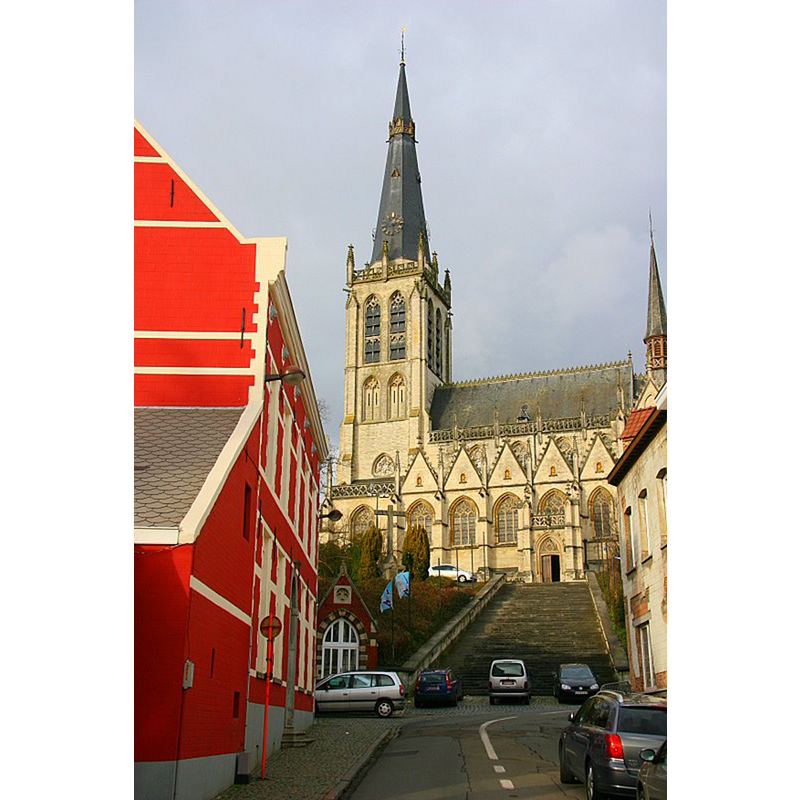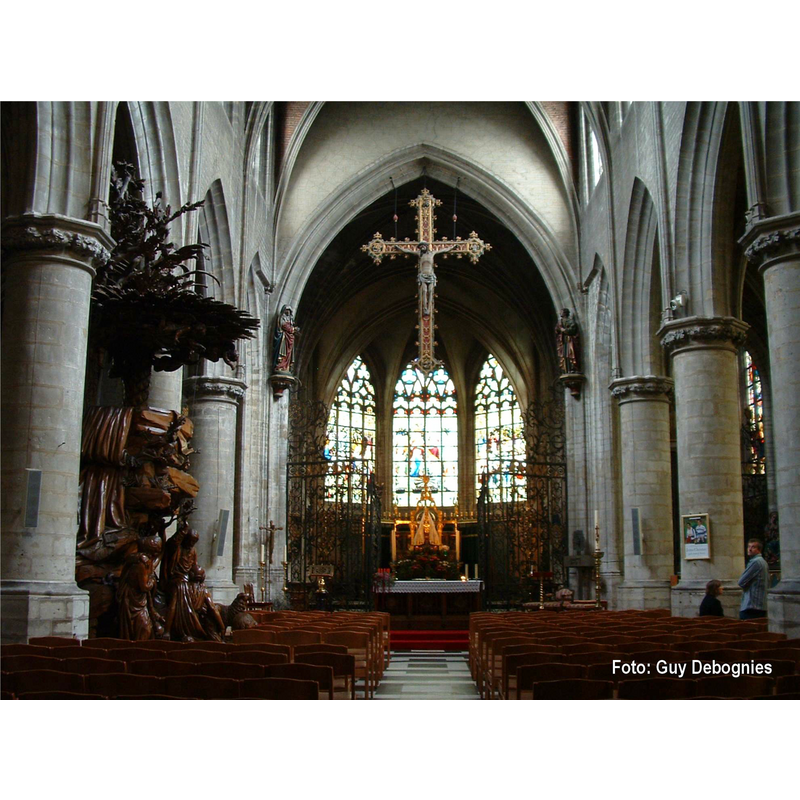Alsemberg

Image copyright © Viktorhauk, 2007
CC-BY-SA-3.0
Results: 9 records
design element - architectural - arch-head - trefoiled
design element - motifs - floral and foliage
design element - motifs - floral and foliage
human figure - head - 4
Scene Description: some broken off [cf. FontNotes]
Copyright Statement: Image copyright © Kerkfabriek OLV Alsemberg, 2021
Image Source: digital photograph by Kerkfabriek OLV Alsemberg [received indirectly without copyright clearing]
Copyright Instructions: PERMISSION NOT AVAILABLE -- IMAGE NOT FOR PUBLIC USE
view of church exterior - south view
view of church interior - nave - looking east
view of font and cover
view of font and cover
view of font and cover in context
Scene Description: showing the cover pulley system
Copyright Statement: Image copyright © Kerkfabriek OLV Alsemberg, 2021
Image Source: digital photograph by Kerkfabriek OLV Alsemberg [received indirectly without copyright clearing]
Copyright Instructions: PERMISSION NOT AVAILABLE -- IMAGE NOT FOR PUBLIC USE
INFORMATION
FontID: 17834ALS
Object Type: Baptismal Font1
Church/Chapel: Onze-Lieve-Vrouw van Alsemberg / Onze-Lieve-Vrouwekerk
Church Patron Saints: St. Mary the Virgin
Church Location: Witteweg, 1652 Beersel, Belgium
Country Name: Belgium
Location: Vlaams-Brabant / Brabant Flamand, Vlaanderen / Flandres
Directions to Site: Located in the municipality and 4 km SE of Beersel, E of highway E19, about 13 km S of Brussels
Font Location in Church: Inside the church
Century and Period: 13th - 14th century [basin only] [composite font], Medieval [composite]
Credit and Acknowledgements: We are grateful to Pol Herman for his help in documenting this font
Church Notes: first church here in 1155; replaced by new church consecrated 1243; present church mid-14thC
Font Notes:
Click to view
Noted in Jan Bols' "De Kerk van Alsemberg en..." (Leuven, 1910: 56) with date ca. 1200; the font had been moved to the rectory at some point, but was returned to the church in 1888 provided with a new granit base. The entry for this church in Inventaris / Vlaanderen [https://id.erfgoed.net/erfgoedobjecten/38859] [accessed 9 September 2021] notes: "Doopvont met romaanse kuip van omstreeks 1200, gerestaureerd in 1888." Baptismal font consisting of a round basin with protruding heads at 90-degree angles [not all the heads have survived]; the spaces between the heads decorated with large vegetal motifs, some forming lovely trafoil-headed arches; the present base, a cluster of a broad central shaft and four outer colonnettes on a square lower base, is modern, but probably not too dissimilar from the original one. Font cover in metal, of conical shape, the sides decorated with patterns drawn from some of those on the basin; foliated finial; modern. Dating for the font has been given as 12th-century and ca. 1200, but the trefoiled arches may suggest the 13th if not the 14th century; the original church was dated to the mid-13th century, but the present church is actually mid-14th century, a more likely date for the font as well. [NB: there is another font, of 1725, in this church].
A communication from Pol Herman to BSI (e-mail of 19 June 2022) notes: " I have read "De Kerk van Alsemberg en..." by Jan Bols, Leuven, 56 p., 1910. He only writes 1 sentence about the font : the romanesque baptismal font dates from about 1200. It was not used anymore and brought to the presbitery. It was put back in the church in 1888. Conform to the drawing by Herman Lemaire, architect from Dworp, a granit base in a fitting style was added by B. van Uytvanck. For documenting the history of a church, I mainly use the heritage website of the Flemish Ministry of Culture. This website is made by professional historians employed by the Ministry. They do a very thorough job, because what they find can have huge legal and financial implications for the owner of the heritage site. For the church of Alsemberg, they mention 3 official studies by the government and 24 bibliographic references. The description of the history starts with (translation of Dutch text) : The duke of Brabant, Godfrey with the Beard, founded a votive church in 1134 and donated it to the abbey of Cambrai, represented by the Deanery of the Holy Sepulcher of the Kapellekerk at Brussels, and twelve acres of land, known as the current 'kerkenberg'. According to C. Theys, the first church building was erected by Abbot Parwin in 1155. From 1219 onwards a Romanesque church was built, which was consecrated on November 30th, 1243. In 1242 Duchess Sophie of Brabant is said to have donated a statue of Our Lady to the church. This marked the beginning of Alsemberg being a place of pilgrimage. Several other donations are known from the archives: Saint Elisabeth of Hungary and Duchess Maria are said to have paid for the nave and the aisles, Duke John III, Philip the Good, Charles the Bold, Mary of Burgundy, Emperor Charles and Maximilian of Austria all donated stained glass windows that have all been lost. The oldest part of the present church is the choir from the second half of the 14th century, which was vaulted in 1465-1470. The nave was built in the second half of the 15th century. Maybe the confusion about classifying the font is due to the vague definition of what is romanesque and what is gothic, depending on where you are. When the gothic artistic expression was already well under way in France, in Belgium we were still building in a romanesque style. Therefore, I have no other information than that the baptismal font of Alsemberg is late-romanesque. Gothic baptismal fonts in Belgium typically have no decoration on the faces between the heads, and gradually move from a circular to an octagonal bowl. The font at Gorsem [...] would for example be early-gothic. The trefoiled arch-heads famously came into use in Belgium when the cathedral of Tournai was built. I find that the trefoil portals were built between 1141 et 1171. They are called "romanesque". See : DUPERROY Françoise (dir.), DESMET Yves (dir.) Les portails romans de la cathédrale Notre-Dame de Tournai : contextualisation et restauration (Namur : Service public de Wallonie, Direction générale opérationnelle de l’Aménagement du Territoire, du Logement, du Patrimoine et de l’Énergie, Département du patrimoine, 2015), 198 p. Collection Études et documents. Monuments et sites ; 12 ISBN 978-2-930711-10-2. The baptismal font of Gondregnies (not in BSI database) is decorated with trefoiled arcades on all sides. KIK-IRPA BALaT mentions : first halve 13th century. A year ago, Jean-Claude Ghislain wrote me : first third of 13th century, romanesque style with gothic decoration."
COORDINATES
Church Latitude & Longitude Decimal: 50.743008, 4.336048
Church Latitude & Longitude DMS: 50° 44′ 34.83″ N, 4° 20′ 9.77″ E
UTM: 31U 594265 5622098
MEDIUM AND MEASUREMENTS
Material: stone
Font Shape: round (with heads) - mounted
Basin Interior Shape: round
Basin Exterior Shape: round (with heads)
LID INFORMATION
Date: modern
Material: metal, bronze
Apparatus: yes; articulated side crane; metal
Notes: [cf. FontNotes]
![[cf. FontNotes]](/static-50478a99ec6f36a15d6234548c59f63da52304e5/others/permission_not_available.jpg)
